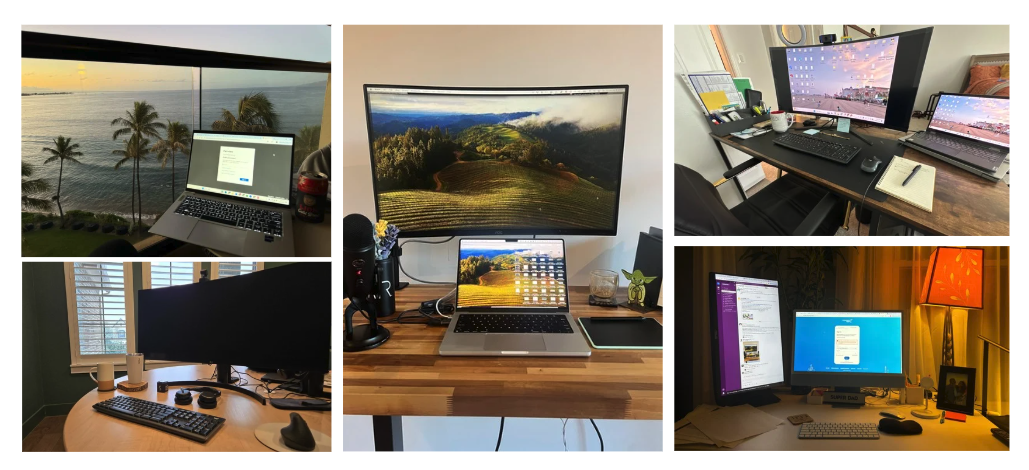
There has been a problem with Learn, please contact the administrator of the academy. Error code: 126692f2-e927-4bf7-b621-e4fd56a48320.
There has been a problem with Learn, please contact the administrator of the academy. Error code: 4b82b286-38b2-4212-9cdd-3b024873e7b9.

Your telemedicine practice depends on a well-organized setup that boosts efficiency and supports high-quality, HIPAA-compliant care. A dedicated home office—with reliable hardware, proper lighting, secure connections, and a distraction-free environment—helps minimize technical issues and streamline your workflow.
This section outlines practical guidelines on the essential hardware, software, and workspace configurations needed to build a productive and compliant telemedicine environment.
- Set up a professional telemedicine workspace that enhances patient trust and workflow efficiency.
- Select the best hardware (computers, cameras, microphones, lighting) for high-quality video visits.
- Ensure high-speed, stable internet connectivity to avoid disruptions during patient interactions.
- Follow HIPAA compliance best practices when working with multiple telehealth platforms and EHRs.
- Optimize your workspace ergonomics for comfort and productivity during long telehealth sessions.
- Create a backup plan so tech failures don’t disrupt your patient schedule.
This video provides a quick guide to setting up a telemedicine home office that maximizes efficiency and ensures HIPAA compliance. We’ll cover the essential hardware, software, and workspace configurations needed to streamline your workflow and minimize technical issues, helping you deliver smooth and professional virtual consultations.
Choosing the Right Hardware for Telemedicine
Having the right tech setup is crucial for smooth video calls, clear communication, and efficient documentation. Below are the essential hardware recommendations for telemedicine professionals.
Computer & Monitors
Your computer is your primary workstation. A fast, reliable setup ensures seamless multitasking during telehealth visits and documentation.
Laptop or Desktop Recommendations
- Budget Option: Acer Aspire 5 (Intel i5, 16GB RAM) – ~$599
- Mid-Range Option: Apple MacBook Air M2 (16GB RAM) – ~$1,099
- High-Performance Option: Dell XPS 15 (Intel i7, 32GB RAM, 1TB SSD) – ~$1,999
Tip: If using a laptop, consider a docking station to connect multiple monitors, peripherals, and accessories easily.
Dual Monitors (Highly Recommended)
A dual-screen setup enhances workflow efficiency—one screen for telehealth visits, the other for EHR and notes.
Recommended Monitors:
- Dell Ultrasharp 27” Monitor – ~$349
- LG 34” UltraWide Monitor – ~$599
Tip: Ultrawide monitors can replace dual monitors for an immersive experience.
Camera & Video Quality
A high-quality camera ensures clear visibility, reinforcing professionalism and patient trust.
Best External Webcams for Telehealth
- Budget Option: Logitech C920 HD Webcam – ~$69
- Mid-Range Option: Logitech Brio 4K Webcam – ~$179
- High-End Option: Razer Kiyo Pro with HDR – ~$199
- Position your camera at eye level for better patient engagement.
- Use a clip-on ring light for improved lighting and clarity.
Microphone & Audio Quality
Clear audio is just as important as video. External microphones enhance voice clarity, reduce background noise, and improve overall professionalism.
Best Microphones for Telemedicine
- Budget Option: FIFINE USB Microphone – ~$39
- Mid-Range Option: Blue Yeti USB Microphone – ~$129
- High-End Option: Shure MV7 USB/XLR Microphone – ~$249
Tip: A desk-mounted boom arm keeps the microphone in an optimal position while freeing up desk space.
Headsets & Audio Accessories
A good headset minimizes background noise and improves call clarity—essential for HIPAA-compliant, confidential conversations.
Recommended Headsets for Telehealth
- Budget Option: Jabra Evolve 20 Wired Headset – ~$49
- Mid-Range Option: Logitech Zone Wireless Headset – ~$159
- High-End Option: Bose Noise Cancelling 700 – ~$379
Tip: Choose a wired headset for reliability or a wireless headset for flexibility.
Additional Accessories for a Smooth Telemedicine Setup
- Ring Light with Adjustable Brightness – Improves visibility and video clarity.
- Ergonomic Office Chair – Ensures comfort for long consultations.
- Standing Desk or Desk Converter – Provides flexibility for extended work hours.
- Privacy Screen Filter – Enhances HIPAA compliance by protecting sensitive patient data.
HIPAA Compliance & Data Security in Multi-Platform Work
Most telemedicine physicians don’t use their own HIPAA-compliant tools—they work with multiple companies, EHRs, and telehealth platforms. While the companies you work with handle compliance, you are still responsible for following HIPAA best practices to protect patient privacy.
HIPAA Considerations When Using Multiple Telehealth Platforms
1. Be mindful of how you access and store patient information.
- Use approved, encrypted platforms for all telehealth visits.
- Avoid copying or storing patient information outside of company-provided EHRs.
2. Follow company-specific privacy protocols.
- Each telehealth company has different compliance policies—review their policies and follow them.
- Avoid using personal email, texting, or unauthorized storage of patient data.
3. Use strong passwords and multi-factor authentication (MFA).
- If you work with multiple EHRs, use a password manager (e.g., 1Password, LastPass) to keep login credentials secure.
- Enable MFA wherever possible to prevent unauthorized access.
Privacy & Security Best Practices in a Multi-EHR Environment
1. Use a secure, private internet connection.
- Never use public Wi-Fi for telemedicine work.
- If working from different locations, use a Virtual Private Network (VPN) for extra security.
2. Best VPNs for Telemedicine
- NordVPN – $4.99/month
- ExpressVPN – $8.32/month
3. Keep personal and professional devices separate.
- If possible, use a company-provided device for telehealth sessions.
- If using your own device, don’t mix personal and work-related data.
Tip: If you’re switching between multiple EHRs and platforms, log out completely when switching between companies to prevent data mix-ups.
Travel Necessities for Telemedicine Provider
A well-prepared travel setup ensures security, professionalism, and uninterrupted workflow when conducting telemedicine visits on the go. Below are essential tools and accessories for maintaining privacy, connectivity, and efficiency while traveling.
Privacy & Security Essentials
When working remotely, protecting patient data and ensuring a HIPAA-compliant setup is critical.
Privacy Screens for Laptops & Tablets
A privacy screen limits viewing angles, preventing others from seeing sensitive information.
- Budget Option: Kensington Snap-On Privacy Screen (~$39)
- Best for MacBooks: SightPro Magnetic Privacy Screen (~$49)
- Best for Windows & Tablets: 3M Privacy Filter (~$59)
Tip: Use screen positioning and brightness control to further reduce visibility in public spaces.
VPN & Secure Network
A Virtual Private Network (VPN) encrypts your internet connection, keeping patient data safe.
- Best VPNs:
✔ NordVPN (Most secure, easy-to-use)
✔ ExpressVPN (Fast speeds for video calls)
✔ ProtonVPN (Privacy-focused)
Tip: Never use public Wi-Fi for patient interactions unless connected to a VPN.
Noise-Canceling Headphones
Clear audio and background noise reduction ensure confidentiality and professionalism during calls.
- Budget: Anker Soundcore Life Q30 (~$79)
- Mid-Range: Sony WH-1000XM4 (~$279)
- High-End: Bose Noise Cancelling 700 (~$379)
Tip: Avoid using built-in laptop speakers and mics in public settings—use a headset or earbuds instead.
Reliable Connectivity & Backup Power
Ensure stable internet and power to avoid interruptions during patient visits.
Mobile Hotspot for Internet Access
A dedicated hotspot ensures stable, secure connectivity when traveling.
- Best for Nationwide Coverage: Verizon Jetpack MiFi 8800L
- Best for Speed & Performance: AT&T Netgear Nighthawk M6
- Best for Global Use: Skyroam Solis Lite
Tip: Some cellular plans allow you to use your phone as a hotspot, but a dedicated device provides better stability and battery life.
Travel-Friendly Power Backup
Unexpected power issues can disrupt sessions—keep backup power solutions on hand.
- Portable Charger: Anker PowerCore+ 26800mAh (~$89) (Charges laptops, tablets, phones)
- Compact Travel Power Strip: Anker PowerPort Cube (~$29) (Multiple USB & AC outlets)
- Uninterruptible Power Supply (UPS): CyberPower 1500VA (~$179) (Prevents sudden shutdowns)
Tip: Always fully charge your laptop, tablet, and backup power banks before traveling.
Ergonomic & Portable Work Setup
Traveling doesn’t mean sacrificing comfort and efficiency.
Laptop Stand & External Accessories
A lightweight, ergonomic setup prevents strain and enhances efficiency.
- Foldable Laptop Stand: Nexstand K1 (~$29) (Portable, height-adjustable)
- Compact Bluetooth Keyboard & Mouse: Logitech MX Keys Mini & MX Anywhere 3 (~$99 each)
- Clip-on Ring Light: Lume Cube Video Conference Light (~$49) (For improved video quality in low light)
Tip: A good posture setup prevents eye strain and neck fatigue during long telemedicine calls.
Final Checklist & Next Steps
- Test your mobile setup before traveling to ensure everything runs smoothly.
- Secure your devices & data with VPNs, strong passwords, and cloud storage.
- Pack essential accessories like chargers, noise-canceling headphones, and a backup internet source.
- Evaluate your current travel setup and make 1-2 improvements today for a smoother experience!
Backup Plans for Tech Failures
Even the best setups can experience tech failures—having a solid backup plan prevents disruptions during patient visits and ensures continuity of care.
Essential Backup Equipment
A strong backup system includes alternative devices, internet access, and power solutions to keep your telehealth practice running smoothly.
Backup Laptop or Tablet
If your primary computer fails, a backup laptop or tablet allows you to continue patient visits with minimal downtime.
- Recommended Devices:
- Apple iPad Pro (12.9”, WiFi + Cellular) – Ideal for video calls & EHR access
- Microsoft Surface Pro 9 – Full Windows experience in a tablet format
- Lenovo ThinkPad X1 Carbon – Lightweight yet powerful backup laptop
Tip: Keep your backup device charged and updated to avoid delays when switching over.
Mobile Hotspot for Internet Outages
A mobile hotspot ensures you stay connected if your primary internet goes down.
- Recommended Hotspots:
- Verizon Jetpack MiFi 8800L – Reliable with strong coverage
- T-Mobile 5G Hotspot – Best for high-speed backup internet
- AT&T Netgear Nighthawk M6 – Powerful 5G option
Tip: Have a backup data plan with at least 10GB per month for emergency use.
Uninterruptible Power Supply (UPS) for Power Failures
A UPS battery backup protects against sudden power outages, giving you enough time to finish a call or safely switch to a backup system.
- Best Budget: APC UPS Battery Backup (600VA) – ~$79 (Provides ~10-15 minutes of backup power)
- Best for Longer Backup: CyberPower 1500VA UPS – ~$179 (Provides ~60-90 minutes of backup power)
Tip: Plug your router, modem, and laptop into the UPS to keep internet and power running during short outages.
Proactive Tech Failure Prevention
Run a quarterly tech failure drill to test your backup plan. Check:
- Your backup device boots up quickly and has access to EHR systems
- Your mobile hotspot connects and provides stable internet
- Your UPS battery backup powers your essential devices
Final Checklist & Next Steps
What You Need for a Smooth Telemedicine Setup
1. Upgrade Your Tech – Ensure high-quality patient interactions with a reliable internet connection, a professional webcam, and clear audio.
2. Follow HIPAA Compliance – Maintain patient confidentiality by securely accessing EHRs and working only with HIPAA-compliant platforms and communication tools.
3. Secure Your Workspace – Protect patient data by using:- VPNs for encrypted connections
- Strong, unique passwords with two-factor authentication
- Private, high-speed internet (avoid public Wi-Fi)
4. Have a Backup Plan – Be prepared for power, internet, or tech failures with:
- A backup laptop or tablet
- A mobile hotspot for internet outages
- A UPS battery backup to keep essential devices running
5. Take Action Today! – Evaluate your current setup and make at least 1-2 improvements to enhance efficiency, professionalism, and compliance.
Next Steps:
- Test your internet speed and upgrade if needed.
- Review your video and audio quality—consider a webcam or microphone upgrade.
- Ensure your backup plan is functional and ready to go.

RESULT:
Approved
Your score:
Here’s your quiz result! Thank you for completing the quiz. Your effort in testing your knowledge is valuable. Whether you nailed it or learned something new, this quiz is a step forward in your understanding of telemedicine. Keep up the great work and continue building on your knowledge!
Congratulations on passing this knowledge check! Good job and keep up the great work.

RESULT:
Retake
Your score:
Here’s your quiz result! Thank you for completing the quiz. Your effort in testing your knowledge is valuable. Whether you nailed it or learned something new, this quiz is a step forward in your understanding of telemedicine. Keep up the great work and continue building on your knowledge!
Looks like you missed a few. Please retake the quiz!
Instructions:
- Choose the best answer for each question.
- Each question has three answer options, but only one correct choice.
- This quiz will test your understanding of hardware setup, security, HIPAA compliance, and backup planning for telemedicine.
Checklist of Technology Setup
A checklist of activity is a structured tool that outlines the tasks or steps required to complete a process or project. It ensures that each essential action is tracked and executed, thereby reducing the risk of oversight and improving overall efficiency.Telemedicine Workspace Design Checklist
The Telemedicine Workspace Design Checklist is a tool that helps healthcare providers create efficient, secure, and compliant environments for delivering remote care. It outlines key considerations such as technology integration, ergonomic setup, audiovisual quality, and privacy measures to ensure both optimal provider performance and enhanced patient experience.Hardware Selection and Setup Guide
A Hardware Selection and Setup Guide serves as a concise roadmap for choosing the right components tailored to your system’s needs, ensuring compatibility and optimal performance. It provides clear, step-by-step instructions for installation and configuration, helping users efficiently build or upgrade their hardware setup.
HIPAA Compliance and Data Security Quick Reference
This quick reference guide provides a concise overview of the key principles and practices necessary for achieving HIPAA compliance, emphasizing the importance of protecting sensitive patient information through robust data security measures. It highlights essential elements such as encryption, access controls, risk assessments, and audit trails to ensure that healthcare organizations maintain regulatory adherence and safeguard data integrity.
Ergonomics and Efficiency Infographic
This infographic on ergonomics and efficiency illustrates how optimal workspace design can enhance productivity and reduce the risk of strain or injury. It provides practical tips and data-driven insights for creating a balanced work environment that supports both employee well-being and operational performance.